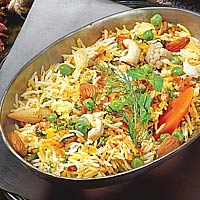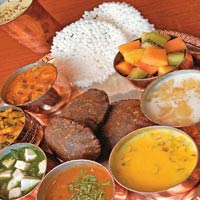Yes, an entire country feasts on these delicacies when they are fasting during the nine days of Navratri. There are nine offerings prescribed for the nine days of Dussehra rituals but all of these are vegetarian. Throughout the country, halwais and sweet shops get busy in preparing the traditional local sweets of their region. Strong aromas of pure desi ghee, milk and dry fruits fill the local bazaars.
And virtually everywhere, people make a beeline for this festival fare. Serpentine queues in front of sweet shops are an everyday spectacle in Ahmedabad during Navratri. People stand in line for hours to bite into hot, crisp, deep fried jalebis and fafda--chickpea flour wafers and both these dishes are considered auspicious. Occasionally confectioners sell rich Rajasthani jalebis which are slightly thicker and fried to a brown colour, fragrant with kesar and a cut above the normal Gujarati variety which are yellowish in colour.
 Delhi leaves no stone unturned to make sure that people get the best of the festival delights. At the Ram Lila grounds, even if you arrive after midnight and are late for the play, you will still be in time to savour some of the best street food Delhi has to offer. Whether you're in the mood for crisp aloo tikkis served with mint chutney, chaat papri, spicy gol gappas, or paranthas, all you have to do is tuck in. Unending rows of food stalls will spoil you for choice, and if you want something made in your particular style--crunchy, soft, hot, or sweet, the hawker will be only to happy to rustle it up.
Delhi leaves no stone unturned to make sure that people get the best of the festival delights. At the Ram Lila grounds, even if you arrive after midnight and are late for the play, you will still be in time to savour some of the best street food Delhi has to offer. Whether you're in the mood for crisp aloo tikkis served with mint chutney, chaat papri, spicy gol gappas, or paranthas, all you have to do is tuck in. Unending rows of food stalls will spoil you for choice, and if you want something made in your particular style--crunchy, soft, hot, or sweet, the hawker will be only to happy to rustle it up.
While you spend time in Delhi sampling street food, in Kolkata, you should go pandal hopping. There is a completely different flavour to the food here--from the soft, crumbly sandesh to spongy, juicy rasgullas. The weakness that Bengalis have for sweets is famous, and the pandal food stalls won't disappoint any foodie. Abiding by custom, Bengalis only eat vegetarian fare from Ashtami, the eighth day till Vijaydashami, the tenth day. Traditional Ashtami fare consists of jackfruit curry, brinjal in spicy curd, tomato chutney and a mixed vegetable curry followed by sweets for consolation. And, in the evening, there are mouth-watering delicacies like sweets (of course) and nimkis, a crispy treat made of flour. But the thing to look forward to is the Durga Puja dinner--a feast consisting of mutton curry, luchis or deep fried, soft puris, aloo dam, boondiya and a host of other delicious treats.
Now step back in time, and move over to the erstwhile royal state of Mysore, where different delicacies were prepared and offered to the goddess Chamundi. These included the wheat cake called obbattu, which is thick tortilla, stuffed with coconut, brown sugar and cardamom; steamed dumplings made of spiced rice flour; and different types of sweet puddings made of milk. People have not forgotten all this, and you can still sample these if you happen to be in the city. The special Dussehra Food Mela offers cuisines from around the country, but to get the local flavour, opt for a traditional Mysore meal--a spread that includes a number of essential rice based dishes like chitranna (rice with lime juice, green chilli turmeric powder sprinkled with fried groundnuts and coriander leaves), vangibath (spiced rice with egg plant) or pulliyoigrae (rice flavoured with tamarind juice and garnished with groundnuts). Mysore Pak made from ghee, sugar and chick pea is the most delicious item on the menu.
 Each place has a different tradition. Kheer and puris are made in most Mumbai homes. In most of the cities in south India, all women guests coming home are offered 'haldi-kumkum' with betel leaves, areca nuts and fruits. Chundal, or nine different kinds of lentils, are offered and distributed to visitors and neighbours. Wherever you go, glistening thalis heaped with regional sweets and delicacies will leave you yearning for more. After all, what's festivity without food?
Each place has a different tradition. Kheer and puris are made in most Mumbai homes. In most of the cities in south India, all women guests coming home are offered 'haldi-kumkum' with betel leaves, areca nuts and fruits. Chundal, or nine different kinds of lentils, are offered and distributed to visitors and neighbours. Wherever you go, glistening thalis heaped with regional sweets and delicacies will leave you yearning for more. After all, what's festivity without food?
Courtesy: Travel Plus

